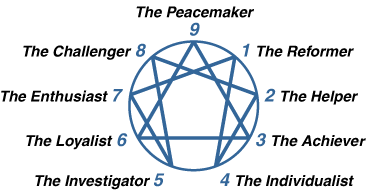Once you’ve figured out your Enneagram type, you may find yourself wondering what is the rarest enneagram type.
There are many theories on the rarest enneagram type on the internet but most of these are based on personal experiences and opinions.
Although surveys have their limitations as well, the most accurate and unbiased answer would be backed by data and statistics.
What Is The Rarest Enneagram Type?
From my research, I discovered the Enneagram Population Distribution which is a massive survey conducted on 189,957 individuals.
The results from the survey indicate that the rarest Enneagram is Type 5, followed closely by Type 8 and Type 2.

What Is So Special About Enneagram Type 5?
Enneagram Type 5 is a truly unique and intriguing personality type. These individuals are characterized by their intense intellectual curiosity, a profound desire for knowledge, and a strong need for autonomy. They are often seen as the scholars, thinkers, and experts in their chosen fields. Here’s what makes them special:
- Intellectual Depth: Type 5s are known for their love of learning and their insatiable thirst for knowledge. They dive deep into subjects that interest them, becoming experts in their domains.
- Independence: They cherish their independence and often prefer solitude to recharge and focus on their intellectual pursuits.
- Minimalism: Type 5s tend to live simple, uncluttered lives, valuing their resources and energy for what truly matters to them.
What Makes Enneagram Type 5 Rare?
Enneagram Type 5 is considered one of the rarest personality types, comprising only a small percentage of the population. Several factors contribute to their rarity:
- Intensity: Type 5s’ intense intellectual and emotional worlds can be challenging for others to understand, making them stand out in a crowd.
- Reserved Nature: They tend to be reserved and private, which can make them less visible in social settings.
- Selective Relationships: Type 5s are highly selective about the people they allow into their inner circle, leading to smaller social circles.
What Motivates a Type 5?
To truly understand a Type 5, it’s essential to delve into their core motivations:
- Fear of Incompetence: At their core, Type 5s fear being incapable or ignorant. They seek knowledge and competence to counteract this fear.
- Need for Privacy: They value their privacy as a way to protect their inner world and recharge their mental energy.
- Desire for Understanding: Type 5s are motivated by a deep desire to understand themselves and the world around them.
What Type 5 Brings to the World
Despite their rarity, Enneagram Type 5s bring valuable contributions to society:
- Expertise: They excel in their chosen fields, often pushing the boundaries of knowledge and innovation.
- Problem Solving: Their analytical minds make them excellent problem solvers, capable of finding creative solutions.
- Independence: Type 5s serve as examples of self-sufficiency and the power of self-discovery.
How to Recognize a Type 5
Identifying a Type 5 can be challenging due to their reserved nature, but there are some common characteristics to look for:
- Depth of Knowledge: They possess in-depth knowledge about specific subjects, often sharing it passionately.
- Reserved Demeanor: Type 5s tend to be quiet and reserved in social settings, observing more than participating.
- Self-Reliance: They are independent and may prefer to handle challenges on their own.
What Makes a Type 5 Happy?
Understanding what brings joy to a Type 5 is crucial for nurturing their well-being:
- Intellectual Stimulation: Engaging in meaningful intellectual pursuits and learning opportunities.
- Solitude: Providing them with space and time alone to recharge their mental energy.
- Autonomy: Allowing them the freedom to make decisions and pursue their interests independently.
What Is The Most Common Enneagram Type?
The results from the survey indicate Type 9 is the most common Enneagram type, followed closely by Type 6 and Type 4.
Limitations of The Enneagram Type Distribution Survey
One limitation of surveys is some Enneagram types may be underrepresented because some Enneagram types are more likely to participate in a survey than others.
For example, Type 4s are potentially the type that tends to be most naturally interested in introspection. As a result, Type 4s would be more likely to search for and participate in this survey. So, their population might be slightly fewer in terms of percentage on a real scale.
Other Enneagram Type Distribution Theories
1. Evenly Distributed
A popular theory states that all nine Enneagram types are evenly distributed among the population. This means that each Enneagram type represents 11.11% of the general population.
This seems to correlate with the results from the survey above. Although the survey results suggest some Enneagram types are rarer than others, the percentages range between 6% – 14.4% which is not too far off from 11.11%.
Taking into the Enneagram type representation limitation above, it supports the theory that the nine Enneagram types are evenly distributed.
2. Primary Types: Type 3, Type 6, Type 9

Source: Enneagram Institute
The Primary Types Theory suggests that Enneagram Type 3, Type 6, and Type 9 are the most common Enneagram types because they are the primary types.
If you look closely at the Enneagram diagram, you’ll notice that Types 3, Type 6, and Type 9 are the only types that are joined by the equilateral triangle in the center.
These three types represent the core Enneagram energies of each Triad.
The Enneagram uses building blocks based on the Law of Threes which states that every whole phenomenon is composed of three separate sources.
In this case, there are three triads, each with three personality types associated with them. The other numbers make up the other six types and represent variations on these three main types.
This theory seems to correlate with the survey results above. Type 3, Type 6, and Type 9 all ranked above average (11.11%) in the surveyed population, with Type 9 being the most common Enneagram type.
Download Your Enneagram Planner
Dive deeper into the world of Enneagram with an Enneagram Planner.
This 11-page printable set is perfect for Enneagram enthusiasts who want to use their Enneagram type for personal growth, relationships, and self-discovery.
